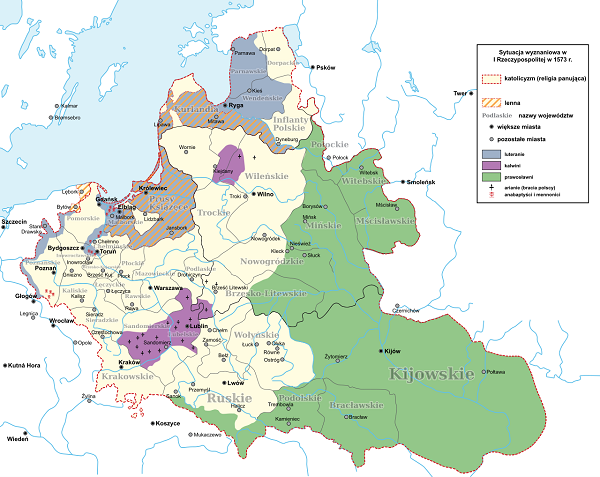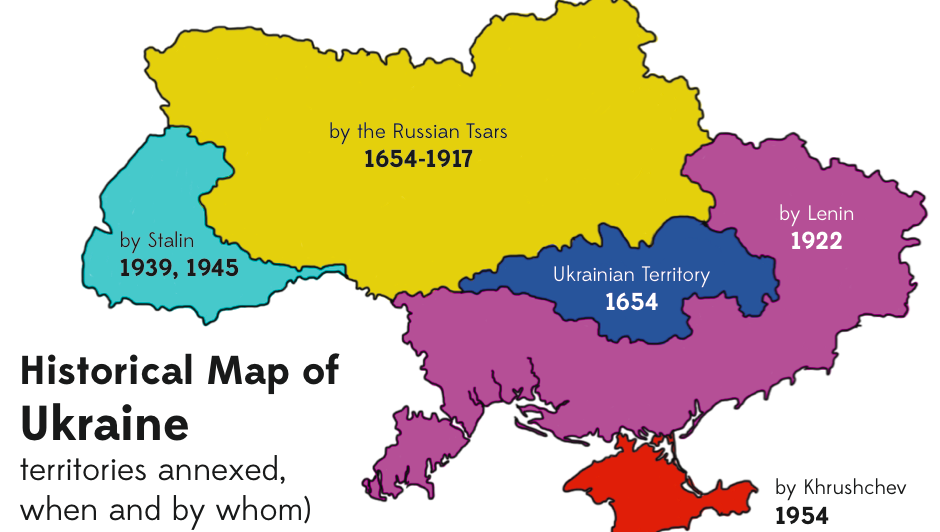The process of self-constructing identity of the Ukrainians after 1991 is basically oriented vis-à-vis Ukraine's two most powerful neighbors: Poland and Russia. In the other words, the self-constructing Ukrainian identity (like the Montenegrin or the Belarus) is able so far just to claim that the Ukrainians are not both the Poles or the Russians but what they really are is of a great debate. Therefore, an existence of an independent state of Ukraine, nominally as a national state of the Ukrainians, is of a very doubt indeed from both perspectives: historical and ethnolinguistic.
The Slavonic term Ukraine, for instance, in the Serbo-Croat case Krajina, means in the English language a Borderland - a provincial territory situated on the border between at least two political entities: in this particular historical case, between the Kingdom of Poland and the Grand Duchy of Lithuania as the Republic of Both Nations (1569−1795) and the Russian Empire. A German historical term for Ukraine would be a mark - a term for the state's borderland which existed from the time of the Frankish Kingdom/Empire of Carl the Great . The term is mostly used from the time of the treaty (truce) of Andrussovo in 1667 between these two states.
In the other words, Ukraine and the Ukrainians as a natural objective-historical-cultural identity never existed as it was considered only as a geographic-political territory between two other natural-historical entities (Poland and Russia).
All (quasi)historiographical mentioning of this land and the people as Ukraine/Ukrainians referring to the period before the mid-17th century are quite scientifically incorrect but in a majority of cases politically inspired and colored with the purpose to present them as something crucially different from the historical process of ethnic genesis of the Russians [for instance: Alfredas Bumblauskas, Genutė Kirkienė, Feliksas Šabuldo (sudarytojai), Ukraina: Lietuvos epocha, 1320−1569, Vilnius: Mokslo ir enciklopedijų leidybos centras, 2010].
It was a Roman Catholic Vatican that was behind the process of creation of the "imagined community" of the "Ukrainian" national identity for the very political purpose to separate the people from this borderland territory from the Orthodox Russian Empire. Absolutely the same was done by Vatican's client Austria-Hungary in regard to the national identity of Bosnian-Herzegovinian population when this province was administered by Vienna-Budapest from 1878 to 1918 as it was the Austria-Hungarian government who created totally artificial and very new ethnolinguistic identity - the "Bosnians", just not to be the (Orthodox) Serbs (who were at that time a strong majority of the provincial population) [Лазо М. Костић, Наука утврђује народност Б-Х муслимана, Србиње−Нови Сад: Добрица књига, 2000.].
A creation of ethnolinguistically artificial Ukrainian national identity and later on a separate nationality was part of a wider confessional-political project by the Vatican in the Roman Catholic historical struggle against the eastern Orthodox Christianity (the eastern "schism") and its Churches within the framework of Pope's traditional proselytizing policy of reconversion of the "infidels". One of the most successful instruments of a soft-way reconversion used by the Vatican was to compel a part of the Orthodox population to sign with the Roman Catholic Church the Union Act recognizing at such a way a supreme power by the Pope and dogmatic filioque ("and from the Son" - the Holy Spirit proceeds and from the Father and from the Son). Therefore, the ex-Orthodox believers who now became the Uniate Brothers or the Greek Orthodox believers became in a great number later on pure Roman Catholics but as well as changed their original (from the Orthodox time) ethnolinguistic identity. It is, for instance, very clear in the case of the Orthodox Serbs in Zhumberak area of Croatia - from the Orthodox Serbs to the Greek Orthodox, later the Roman Catholics and finally today the Croats. Something similar occurred and in the case of Ukraine. On October 9th, 1596 it was announced by the Vatican a Brest Union with a part of the Orthodox population within the borders of the Roman Catholic Lithuanian-Polish Commonwealth (today Ukraine) [Arūnas Gumuliauskas, Lietuvos istorija: Įvykiai ir datos, Šiauliai: Šiaures Lietuva, 2009, 44; Didysis istorijos atlasas mokyklai: Nuo pasaulio ir Lietuvos priešistorės iki naujausiųjų laikų, Vilnius: Leidykla Briedis, (without year of publishing) 108.]. The crucial issue in this matter is that today Ukraina's Uniates and the Roman Catholics are most anti-Russian and of the Ukrainian national feelings. Basically, both the Ukrainian and the Belarus present-day ethnolinguistic and national identities are historically founded on the anti-Orthodox policy of the Vatican within the territory of ex-Polish-Lithuanian Commonwealth that was in essence an anti-Russian one.
The Lithuanian historiography writing on the Church Union of Brest in 1596 clearly confirms that:
"... the Catholic Church more and more strongly penetrated the zone of the Orthodox Church, giving a new impetus to the idea, which had been cherished since the time of Jogaila and Vytautas and formulated in the principles of the Union of Florence in 1439, but never put into effect - the subordination of the GDL Orthodox Church to the Pope's rule" [Zigmantas Kiaupa et al, The History of Lithuania Before 1795, Vilnius: Lithuanian Institute of History, 2000, 288].
In the other words, the rulers of the Roman Catholic Grand Duchy of Lithuania (the GDL) from the very time of Lithuania's baptizing in 1387−1413 by the Vatican had a plan to Catholicize all Orthodox believers of the GDL among whom overwhelming majority were the Slavs. As a consequence, the relations with Moscow became very hostile as Russia accepted a role of the protector of the Orthodox believers and faith and therefore the Church Union of Brest was seen as a criminal act by Rome and its client the Republic of Two Nations (Poland-Lithuania).

In general, the western territories of the present-day Ukraine are mainly populated by the Roman Catholics, the East Orthodox and the Uniates. This part of Ukraine is mostly nationalistic and pro-western oriented. The East Ukraine is in essence Russophone and subsequently "tends to look to closer relations with Russia" [John S. Dryzek, Leslie Templeman Holmes, Post-Communist Democratization: Political Discourses Across Thirteen Countries, Cambridge−New York: Cambridge University Press, 2002, 114].





Reader Comments